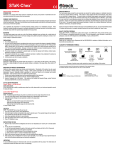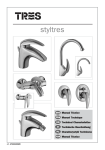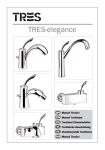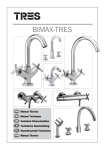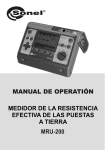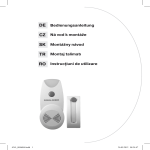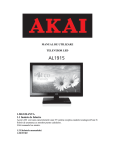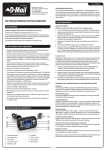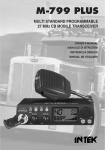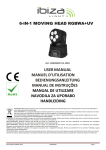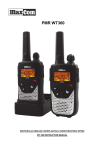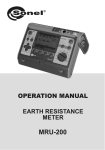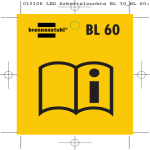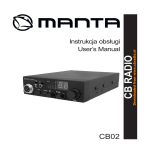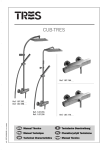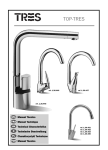Download CH - CBradio.nl
Transcript
M-130 PLUS MULTI STANDARD PROGRAMMABLE 27 MHz CB MOBILE TRANSCEIVER OWNER'S MANUAL MANUALE DI ISTRUZIONI INSTRUKCJA OBSL/ UGI MANUAL DE UTILIZARE Downloaded from www.cbradio.nl Declaration of Conformity EC Certificate of Conformity (to EC Directive 2006/95, 2004/108, 99/5) DECLARATION OF CONFORMITY With the present declaration, we certify that the following products : INTEK M-130 PLUS comply with all the technical regulations applicable to the above mentioned products in accordance with the EC Directives 2006/95/EC, 2004/108/EC, 99/5/EC. Type of product : CB Transceiver Details of applied standards : EN 300 433-1/-2, EN 300 135-1/-2 EN 301 489-1, EN 301 489-13 EN 60065 Manufacturer : INTEK S.R.L. Via G. Marconi, 16 20090 Segrate, Italy Tel. 39-02-26950451 / Fax. 39-02-26952185 E-mail : [email protected] Notified Body : EMCCert Dr. Rasek Boelwiese 5, 91320 Ebermannstadt Germany Identification Number : 0678 Contact Reference : Armando Zanni Tel. 39-02-26950451 / Fax. 39-02-26952185 E-mail : [email protected] Segrate, 02/02/2010 dr. Vittorio Zanetti (General Manager) NOTICE ! It is recommended to carefully read this owner’s manual before using the product. This will also help the user to prevent using the radio in violation of the regulations valid in the country where the product is used, as well as to avoid any possible interferences with other services. 0678 CH RoHS 2002/95/EC Index - Introduction - Content of the packaging . . . . . . . . . . . . . . . . . . . . . . . . . . . . . . . . . . . . . . . . . .1 Controls, Indicators and operation . . . . . . . . . . . . . . . . . . . . . . . . . . . . . . . . . . . . . . . . . . . . . . . . . . 2 - 5 Installation . . . . . . . . . . . . . . . . . . . . . . . . . . . . . . . . . . . . . . . . . . . . . . . . . . . . . . . . . . . . . . . . . . . . . . . . 6 Installing and connecting the mobile antenna with magnet base (Full Kit Version) . . . . . . . . . . . . . 7 Frequency bands table - User Information . . . . . . . . . . . . . . . . . . . . . . . . . . . . . . . . . . . . . . . . . . . . . . 8 Frequency band selection / programming . . . . . . . . . . . . . . . . . . . . . . . . . . . . . . . . . . . . . . . . . . . . . . 9 Table of restrictions on the use of CB transceivers . . . . . . . . . . . . . . . . . . . . . . . . . . . . . . . . . . . . . . . 9 Specifications . . . . . . . . . . . . . . . . . . . . . . . . . . . . . . . . . . . . . . . . . . . . . . . . . . . . . . . . . . . . . . . . . . . . . 10 Table of restrictions on the use of CB transceivers . . . . . . . . . . . . . . . . . . . . . . . . . . . . . . . . . . . . . . . I PCB - Main Board & Front Board . . . . . . . . . . . . . . . . . . . . . . . . . . . . . . . . . . . . . . . . . . . . . . . . . . . II-III Diagram . . . . . . . . . . . . . . . . . . . . . . . . . . . . . . . . . . . . . . . . . . . . . . . . . . . . . . . . . . . . . . . . . . . . . . . . IV-V Block Diagram . . . . . . . . . . . . . . . . . . . . . . . . . . . . . . . . . . . . . . . . . . . . . . . . . . . . . . . . . . . . . . . . . .VI-VII Notes . . . . . . . . . . . . . . . . . . . . . . . . . . . . . . . . . . . . . . . . . . . . . . . . . . . . . . . . . . . . . . . . . . . . . . . . .VIII-IX NOTICE ! Before using this transceiver, please check that the radio has been programmed on the frequency bands, specifications and operating modes allowed by the regulations valid in the country where the product is used. If not, please proceed to modify the frequency band programming, as it is described in this owner’s manual. This transceiver is factory pre-programmed on the CE European frequency band (CEPT 40CH FM 4W). Congratulations! Congratulations for selecting and purchasing an INTEK quality product. This transceiver includes a number of advanced functions and systems, therefore it is definitely necessary to carefully read this owner’s manual before using the radio. With a correct use of the product in accordance with the operating method described in this manual, the product will offer a trouble free use for many years. INTEK is constantly engaged to develop and provide quality products meeting the customers requirements, however any suggestion or comment on this product that might help us to improve quality are warmly welcome. INTEK M-130 PLUS is a CB transceiver using advanced hardware and software design, it includes a special multi-standard programmable circuit, which allows to program the specifications of the radio (frequency bands, operating modes, transmitter power) in compliance with the regulations valid in the various European countries. Therefore this product can be used in any country of the European Community. The radio is delivered factory pre-programmed on the CE European frequency band (CEPT 40CH FM 4W). Content of the packaging Please check that all the following items are contained in the packaging : main unit (transceiver) DC power cord with fuse holder and fuse power cord with lighter adaptor plug and fuse (Full Kit version) condenser microphone car mounting bracket car mounting bracket accessories (hardware, knobs, etc.) microphone bracket mobile antenna with magnet base (Full Kit version) owner’s manual -1- English Index - Introduction - Content of the packaging Controls, Indicators and operation English Front Panel 1 2 3 4 A/F ANL EMG TX 5 M-130 PLUS VOLUME SQUELCH RF GAIN AM FM ANL HILO ALPHA CH OFF 11 AS 10 9 8 UP DN 7 6 1. A/F Key This key allows to select the AM or FM operating mode, in both TX and RX. The AM/FM operating mode selection is possible only if it if allowed by the programmed frequency band, otherwise the AM/FM selection is not possible. 2. ANL Key Press the ANL key (2) to enable the ANL (Automatic Noise Limiter) function, in order to reduce electric or electromagnetic noise or interference on the used channel. The ANL (E) icon is lighted to confirm that the ANL function is enabled. Press again the ANL key (2) to disable the function. 3. EMG key (Emergency Channels) This key allows quick access to one of the two pre-programmed emergency channels (CH9 or CH19). Each time this key is pressed, radio will select CH9, then CH19, then again the normal operating channel. 4. TX LED Indicator This red color LED indicator is lighted when radio is in the transmit mode. 5. LCD Display Large size LCD display with blue color backlight function for best readability in darkness. It indicates the operating channel number, the operating mode and all the programmed settings and all the enabled functions. -2- English Controls, Indicators and operation LCD Display A G B AM FM ANL HILO ALPHA F E D C A. Channel Number It indicates the operating channel number or the frequency band ID code. B. ALPHA Icon The ALPHA Icon (B) is lighted when an intermediate channel is selected. This feature is not available on the radios for the European Market. C. LO Icon The LO Icon (C) is lighted when the transmitter is in LOW POWER mode (1W). D. HI Icon The HI Icon (D) is lighted when the transmitter is in HIGH POWER mode (4W). E. ANL Icon The ANL Icon (E) is lighted when the ANL (Automatic Noise Limiter) function is enabled. F. FM Icon The FM icon (F) is lighted when radio has been set to the FM (Frequency Modulation) operating mode. G. AM Icon The AM icon (G) is lighted when radio has been set to the AM (Amplitude Modulation) operating mode. 6. DN (Down) Key This key allows to select the operating channel downward. By keeping this key pressed, the quick channel selection mode will be enabled. 7. UP (Up) Key This key allows to select the operating channel upward. By keeping this key pressed, the quick channel selection mode will be enabled. 8. RF GAIN Control This transceiver uses a high sensitivity and selectivity receiver circuit. The receiver gain is adjustable with the RF GAIN control (8). By turning the knob clockwise, the receiver gain is increased. It is convenient to reduce the receiver gain in case of very strong signals from local stations and to increase it in case of weak signals or long distance communications. -3- Controls, Indicators and operation English 9. AS/SQUELCH Control SQUELCH CONTROL (SQUELCH manual adjustment) The SQUELCH control allows to silent the receiver by cutting the background noise, when no signals are received. Turn the knob clockwise until the background noise is cut. Turn the knob counter clockwise (SQUELCH opening) in order to listen to the weakest signals. AS CONTROL (SQUELCH fixed setting) The AS function allows to automatically silent the receiver, avoding the SQUELCH manual adjustment. A fixed SQUELCH threshold is factory pre-set. To enable the fixed SQUELCH function, turn the knob fully counter clockwise to the AS position, until a click noise is heard. 10. OFF/VOLUME Control Use this knob to switch radio ON and OFF, as well as to adjust the receiver volume to the desired level. To adjust the receiver volume in case no signals are received on the operating channel, open the SQUELCH and then adjust the receiver volume using the background noise as a reference. 11. Microphone Connector Connect the microphone to this connector and turn the connector ring to lock it. Rear Panel 12 13 EXT ANTENNA DC 13.2V 14 12. EXT (External Speaker) Jack This jack is for connecting an external speaker (optional). 13. ANTENNA Connector Antenna connector. Refer to the sections INSTALLATION OF THE ANTENNA and INSTALLING AND CONNECTING THE MOBILE ANTENNA WITH MAGNET BASE. 14. 13.2VDC POWER CORD 13.2VDC power cord input. FULL KIT VERSION The power cord is complete with lighter adaptor plug and fuse. -4- Microphone 15 16 15. PTT (Push-to-Talk) Key Transmitter key. Press the PTT key (15) to transmit and release it to return to the receive mode. 16. MICROPHONE Plug 4-pin microphone connector with locking ring. Connect it to the microphone connector on the front panel of the radio. IMPORTANT ! Do never attempt to open the cabinet of the transceiver. No user serviceable parts inside. Internal modifications or tampering may cause damage to the product, modify its technical specifications and will void warranty rights. If service or repair are required, please go to an authorised service centre or specialized technician. -5- English Controls, Indicators and operation Installation English Installation Before installing the main unit in the vehicle, check and select the most convenient location, in order that the radio will be easy to reach and comfortable to operate, without disturbing or interfering with the vehicle drive. Use the supplied bracket and hardware to install the radio. The bracket screws must be well tightened in order not to become loosen with the vehicle vibrations. The car mounting bracket can be installed over or below the radio and the radio may be inclined as desired according to the specific type of installation (under dashboard or track cabin roof installation). Installation of the Main Unit Before connecting the radio to the vehicle electric system, make sure that radio is switched off, with the OFF/VOLUME knob (10) completely turned counter clockwise at OFF position. The DC power cable (14) of the radio is complete with a fuse holder with fuse located on the red positive (+) wire. Connect the DC power cable to the vehicle electric system, with special attention to respect correct polarity, even if the radio is protected against polarity inversion. Connect the red wire to the positive (+) pole and the black wire to the negative (-) pole of the vehicle electric system. Make sure that the wires and terminals are firmly and stably connected, in order to prevent cables from disconnecting or causing short circuits. FULL KIT VERSION Connect the lighter adaptor plug (14) to the 12VDC socket of the vehicle. Fuse is located inside the lighter adaptor plug. To replace the fuse unscrew the cap of the plug, remove the fuse and the spring then reinstall all parts by first inserting the spring and then the new fuse. Installation of the Antenna A specific mobile antenna adjusted for 27 MHz frequency range must be used. The antenna installation must be done by a specialised technician or service centre. Please pay special attention to carefully install the antenna on the vehicle with perfect connection to ground. Before connecting the antenna to the radio, it is necessary to check the correct operation of the antenna with low standing wave ratio (S.W.R.), using adequate instruments. If not, the transmitter circuit of the radio could be damaged. The antenna must be usually installed on the highest part of the vehicle, free from obstacles and as far away as possible from any source of electric or electromagnetic noise. The RF antenna coaxial cable must not be damaged or pressed on its way between antenna and the radio. The correct operation of the antenna and the low standing wave ratio (S.W.R.) must be checked periodically. Connect the RF antenna coaxial cable to the antenna connector (13), located on the rear side of the radio. Checking Operation of the Radio Once radio has been connected to the vehicle electric system and to the antenna, the correct operation of the system may be checked. Please proceed as follows : 1) Check that the power cable is correctly connected. FULL KIT VERSION Check that power cord is correctly connected and that the lighter adaptor plug is correctly inserted in the 12VDC socket of the vehicle. 2) Check that the RF antenna coaxial cable is correctly connected. 3) Connect the microphone to the connector (11), located on the front side of the radio. 4) Rotate the AS/SQUELCH knob (9) counter clockwise. 5) Turn radio on using the OFF/VOLUME knob (10) and adjust volume to the desired level. 6) Select the desired channel, using the channel selector keys (6, 7). 7) Rotate the AS/SQUELCH knob (9) clockwise, to cut the background noise. 8) Press the PTT key (15) to transmit and release it to receive. The transceiver will work correctly. -6- FULL KIT VERSION Installing and connecting the mobile antenna with magnet base A 27 MHz mobile antenna with magnet base and 4m RG-58/U is included in the kit. Connect the whip (A) to the magnet base and tighten the locking screw (B) using the supplied tool. Please pay attention to correctly placing the magnet antenna on the vehicle top. The magnet antenna must be firmly attached to the vehicle metal body. Connect the antenna connector (E) to the antenna outlet (13) located on the rear side of the radio. Before turning on and operating the radio, the correct performance of the antenna (S.W.R. ratio) must be check with an S.W.R. meter. If necessary, adjust the length of the whip (A) until a correct S.W.R. ratio is reached. Otherwise the transmitter circuit of the radio might be damaged. Antenna must be usually placed on the highest part of the vehicle, free from nearby metal parts and as far as possible from any possible source of electric or electromagnetic noice. The antenna cable must not be damaged in its way to the radio. Parts description A. Whip Steel whip with protective rubber cup. A B. Locking screw Locking screw for adjusting and tightening the antenna whip, using the supplied tool. C. Magnet base Antenna magnet base to be placed on any iron or steel surface, with no need to drill any hole on the vehicle body. D. RG-58/U Cable RG-58/U cable, 4m long. E. RF Connector PL-259 connector. Connect to the antenna outlet (13), located on the rear side of the radio. B C Warning ! Before turning on and operating radio, make sure that the connector (E) is correctly connected to the antenna outlet (13) located on the rear side of the radio. D E -7- English Installing and connecting the mobile antenna with magnet base Frequency bands table - User Information English Frequency Bands Table The transceiver INTEK M-130 PLUS includes an advanced multi-standard programmable circuit, which allows to program different frequency bands, specifications and operating modes, in conformity with the regulations in the country where the product is used. 9 programmable frequency bands are available, as per the below table : FREQUENCY BAND ID CODE E1 I2 dE d2 EU CE ITALY/SPAIN ITALY GERMANY GERMANY EUROPE/FRANCE CEPT U UK PL PD POLAND POLAND SPECIFICATIONS (Channels, Operating Modes, TX Power) COUNTRY 40CH AM / FM 4W 36CH AM / FM 4W 80CH FM 4W - 12CH AM 1W 40CH FM 4W - 12CH AM 1W 40CH FM 4W - 40CH AM 1W 40CH FM 4W 40CH FM 4W UK FREQUENCIES 40CH FM 4W CEPT FREQUENCIES 40CH AM / FM 4W POLISH FREQUENCIES 40CH AM 1W / FM 4W POLISH FREQUENCIES Attention ! This radio has been factory pre-programmed on the CE frequency band (CEPT 40CH FM 4W), since this standard is currently accepted in all the European countries. Please refer to the information table at page I (Restrictions on the use of CB transceivers). User Information in accordance with art. 13 of the Legislative Decree of 25th July 2005, no. 15 ”Implementation of Directives 2002/95/EC, 2002/96/EC and 2003/108/EC, relative to reduction of the use of hazardous substances in electrical and electronic equipment, in addition to waste disposal”. The crossed bin symbol shown on the equipment indicates that at the end of its working life the product must be collected separately from other waste. The user must therefore take the above equipment to the appropriate differentiated collection centres for electronic and electro technical waste, or return it to the dealer when purchasing a new appliance of equivalent type, in a ratio of one to one. Appropriate differentiated waste collection for subsequent recycling, treatment and environment-friendly disposal of the discarded equipment helps to prevent possible negative environmental and health effects and encourages recycling of the component materials of the equipment. Illegal disposal of the product by the user will be punished by application of the administrative fines provided for by the legislative decree no. 22/1997 (article 50 and following of the legislative decree no. 22/1997). -8- Frequency Band Selection / Programming This two-way CB radio must be programmed and exclusively used on a frequency band allowed in the country where the product is used. When radio is switched ON, the current programmed frequency band code will be displayed (blinking) for about 3 seconds. To program a different frequency band, proceed as follows : 1) Turn OFF the radio. 2) Press and keep pressed the UP key (7), then turn ON the radio using the OFF/VOLUME knob (10). 3) The current frequency band code (A) will blink on the LCD display (5). 4) Now select the new desired frequency band code by pressing the UP (7) or DN (6) key. 5) Press the PTT (15) key or wait for about 5 seconds to confirm and store the new selected frequency band code. UK/CE CHANNELS SELECTION (FREQUENCY BAND "U") If the frequency band "U" (UK band) has been selected, all channels can be scrolled using the channel keys. When a UK frequency channel will be selected the display (5) will show the channel number (A) and the indication "U". When a CEPT frequency channel will be selected the display (5) will show the channel number (A) and the indication "C". Table of Restrictions on the Use of CB Transceivers (page I) The following information are to be considered only just as an indication. They are believed to be correct at the time of printing this operating manual. It is however the user’s responsibility to check that, in the country where radio is used, the regulations for the use of CB transceivers have not been modified. User is therefore suggested to contact the local dealer or local authority, in order to check the current regulations for the use of CB transceivers, before operating this product. The manufacturer does not take any responsibility if the product is used in violation of the regulations of the country where the product is used. Addendum (Updated information on national restrictions) BELGIUM, UK, SPAIN, SWITZERLAND In order to use this transceiver in Belgium, UK, Spain and Switzerland, residence must have an individual licence. Users coming from abroad may freely use the radio in FM mode, while in order to use it in AM mode they must hold a licence released in their own country. ITALY Foreigners arriving in Italy must get an Italian authorization. AUSTRIA Austria does not allow using multi standard programmable CB radios. It is recommended to carefully follow this directives and not to use the product in the Austrian territory. GERMANY Along some border areas in Germany, the radio can not be used as a base station from channel 41 to channel 80. Refer to local authority (notification office) for details. -9- English Frequency band selection / programming Specifications English Specifications General Channels Frequency range Frequency control Operatine temperature DC input voltage Size Weight 40 FM (refer to the frequency bands table at page 8) 27 MHz Citizen Band P.L.L. -10°/+55°C 13.2Vdc ±15% 140 (L) x 37 (H) x 190 (D) mm 750 gr. Receiver System IF Sensitivity Audio output Audio distorsion Image rejection Adjacent channel Signal/noise ratio Current drain Double conversion, CPU controlled super-heterodine 1° 10.695 MHz / 2° 455 KHz 0.5uV for 20dB SINAD (FM) 0.5uV for 20dB SINAD (AM) 2.5W <8% at 1 KHz 65dB 65dB 45dB 350mA (stand-by) Transmitter System Maximum RF power Modulation Impedance Current drain CPU controlled P.L.L. systhesizer 4W at 13.2Vdc 85% to 90% (AM) 1.8 KHz ±0.2 KHz (FM) 50 ohm unbalanced 1300mA (at no modulation) - 10 - Indice - Introduzione - Contenuto della confezione Indice - Introduzione - Contenuto della confezione . . . . . . . . . . . . . . . . . . . . . . . . . . . . . . . . . . . . . . .11 Descrizione dei comandi e funzionamento . . . . . . . . . . . . . . . . . . . . . . . . . . . . . . . . . . . . . . . . . . 12-15 Installazione e collegamenti elettrici . . . . . . . . . . . . . . . . . . . . . . . . . . . . . . . . . . . . . . . . . . . . . . . . . . 16 Tabella bande di frequenza - Avviso agli utenti . . . . . . . . . . . . . . . . . . . . . . . . . . . . . . . . . . . . . . . . . 18 Selezione / programmazione della banda di frequenza . . . . . . . . . . . . . . . . . . . . . . . . . . . . . . . . . . . 19 Tabella delle restrizioni all' uso dei ricetrasmettitori CB . . . . . . . . . . . . . . . . . . . . . . . . . . . . . . . . . . 19 Caratteristiche tecniche . . . . . . . . . . . . . . . . . . . . . . . . . . . . . . . . . . . . . . . . . . . . . . . . . . . . . . . . . . . . 20 Tabella delle restrizioni all' uso dei ricetrasmettitori CB . . . . . . . . . . . . . . . . . . . . . . . . . . . . . . . . . . . I Circuito stampato Main Board e Front Board . . . . . . . . . . . . . . . . . . . . . . . . . . . . . . . . . . . . . . . . . II-III Schema elettrico . . . . . . . . . . . . . . . . . . . . . . . . . . . . . . . . . . . . . . . . . . . . . . . . . . . . . . . . . . . . . . . . . IV-V Schema a blocchi . . . . . . . . . . . . . . . . . . . . . . . . . . . . . . . . . . . . . . . . . . . . . . . . . . . . . . . . . . . . . . .VI-VII Note . . . . . . . . . . . . . . . . . . . . . . . . . . . . . . . . . . . . . . . . . . . . . . . . . . . . . . . . . . . . . . . . . . . . . . . . . .VIII-IX IMPORTANTE ! Prima di utilizzare la ricetrasmittente, verificare che la stessa sia programmata per operare sulle bande di frequenza e nei modi previsti dalle norme di legge in vigore nel paese in cui la radio viene utilizzata. Diversamente procedere alla modifica della programmazione, come indicato in questo manuale di istruzioni. La radio è pre-programmata all' origine sulla banda di frequenza europea CE (CEPT 40CH FM 4W). Congratulazioni ! Congratulazioni per aver scelto ed acquistato un prodotto di qualità INTEK. Questo ricetrasmettitore dispone di numerose funzioni avanzate e vari dispositivi, pertanto è assolutamente necessario leggere attentamente questo manuale di istruzioni prima di utilizzare l' apparecchio. Con un uso corretto secondo quanto è indicato nel manuale di istruzioni, l' apparecchio garantirà un servizio senza problemi per molti anni. Ci impegnamo costantemente a fornire prodotti di qualità che rispondano alle vostre esigenze, ma siamo comunque sempre molto interessati a ricevere eventuali vostri commenti o suggerimenti su questo prodotto, che ci aiutino nel continuo miglioramento della qualità. INTEK M-130 PLUS è un ricetrasmettitore con caratteristiche tecniche di hardware e software molto avanzate e dispone di un circuito di tipo Multi Standard programmabile che consente di configurare i vari parametri dell' apparecchio (bande di frequenza, modi operativi, potenza del trasmettitore) in modo conforme alle norme di legge in vigore nei vari paesi della Comunità Europea. Pertanto questa ricetrasmittente può essere utilizzata in un qualsiasi paese della Comunità Europea. L' apparecchio viene consegnato pre-programmato sulla banda CE (CEPT 40CH FM 4W). Contenuto della confezione Verificare che le seguenti parti siano contenute nella confezione : ricetrasmettitore cavetto di alimentazione DC con porta fusibile e fusibile cavetto con presa accendisigari e fusibile (versione Full Kit) microfono a condensatore staffa di montaggio per veicolo - 11 - accessori per montaggio staffa (viti, pomelli, ecc.) staffa di supporto per microfono antenna con base magnetica (versione Full Kit) manuale di istruzioni Italiano Installazione dell' antenna con base magnetica (versione Full Kit) . . . . . . . . . . . . . . . . . . . . . . . . . 17 Descrizione dei comandi e funzionamento Pannello frontale Italiano 1 2 3 4 A/F ANL EMG TX 5 M-130 PLUS VOLUME SQUELCH RF GAIN AM FM ANL HILO ALPHA CH OFF 11 AS 10 9 8 UP DN 7 6 1. Tasto A/F Questo tasto consente di selezionare il modo operativo AM o FM, in TX e RX, se il modo scelto è abilitato dalla banda di frequenza programmata. 2. Tasto ANL (Automatic Noise Limiter) Premendo brevemente il tasto ANL (2) viene inserito il dispositivo ANL (Automatic Noise Limiter) che permette la riduzione dei disturbi radio elettrici ed elettromagnetici sul canale in uso. L' icona ANL (E) sarà acceso a conferma dell' inserimento del dispositivo. Ripremere il tasto ANL (2) per disattivare il dispositivo ANL. 3. Tasto EMG (Emergency Channels) Questo tasto permette la selezione rapida di uno dei 2 canali di emergenza pre-programmati (CH9 o CH19). Ad ogni pressione del tasto EMG (3), viene impostato il canale CH9, quindi il canale CH19, quindi nuovamente il normale canale in uso. Quando è in uso uno dei canali di emergenza, il numero del canale (A) lampeggia sul display LCD (5). 4. Indicatore LED TX Questo indicatore LED luminoso di colore rosso è acceso quando il ricetrasmettitore è in modalità trasmissione. 5. Display LCD Display LCD di tipo retroilluminato in colore blu, per la massima leggibilità. Il display indica il numero della banda e del canale in uso e tutte le funzioni e i dispositivi attivati. - 12 - Descrizione dei comandi e funzionamento Display LCD Italiano A G B AM FM ANL HILO ALPHA F E D C A. Indicazione del canale L' indicazione consente la lettura del numero del canale in uso o della banda di frequenza selezionata. B. Icona ALPHA L' icona ALPHA è accesa quando vengono visualizzati i canali intermedi, funzione non attiva e non disponibile negli apparati destinati al mercato europeo. C. Icona LO L' icona LO (C) è accesa quando il ricetrasmettitore è in modalità bassa potenza (1W). D. Icona HI L' icona HI (D) è accesa quando il ricetrasmettitore è in modalità alta potenza (4W). E. Icona ANL L' indicazione ANL (E) è accesa quando è abilitato il dispositivo ANL (Automatic Noise Limiter). F. Icona FM L' icona FM (F) è accesa quando il ricetrasmettitore riceve e trasmette in modo FM (modulazione di frequenza). G. Icona AM L' icona AM (G) è accesa quando il ricetrasmettitore riceve e trasmette in modo AM (modulazione di ampiezza). 6. Tasto DN Questo tasto permette la selezione dei canali in ordine decrescente. Mantenendo premuto questo tasto, la selezione dei canali avverrà in modo rapido. 7. Tasto UP Questo tasto permette la selezione dei canali in ordine crescente. Mantenendo premuto questo tasto, la selezione dei canali avverrà in modo rapido. 8. Manopola RF GAIN (guadagno del ricevitore) Questo ricetrasmettitore utilizza un circuito ricevente con alta sensibilità e selettività. Il guadagno del ricevitore è regolabile con la manopola RF GAIN (8). Ruotando la manopola in senso orario, il guadagno del ricevitore viene incrementato. E' opportuno ridurre il guadagno del ricevitore in presenza di segnali molto forti e aumentarlo in caso di segnali deboli o comunicazioni a lunga distanza. - 13 - Descrizione dei comandi e funzionamento 9. Manopola AS/SQUELCH COMANDO SQUELCH (regolazione manuale SQUELCH) Il comando SQUELCH permette di silenziare il ricevitore, eliminando il rumore (fruscio) di fondo in assenza di segnali. Ruotare la manopola in senso orario sino a quando scompare il rumore di fondo. Ruotare la manopola in senso antiorario (apertura dello SQUELCH) per ascoltare i segnali più deboli. Italiano COMANDO AS (regolazione fissa SQUELCH) E' disponibile la funzione AS per silenziare il ricevitore in modo automatico, senza eseguire la regolazione manuale dello SQUELCH. Una regolazione fissa dello SQUELCH è pre-impostata in origine. Per impostare la funzione AS, ruotare la manopola completamente in senso antiorario fino a farla scattare in posizione AS. 10. Manopola OFF/VOLUME Manopola di accensione e spegnimento della radio. Permette la regolazione del volume di ascolto. In assenza di segnali sul canale in uso, si consiglia di aprire lo SQUELCH e quindi di regolare il volume al livello desiderato utilizzando come riferimento il rumore (fruscio) di fondo. 11. Presa per microfono Collegare il microfono in dotazione a questa presa, bloccandolo tramite l’ apposita ghiera. Pannello posteriore 12 13 EXT ANTENNA DC 13.2V 14 12. Presa EXT (External Speaker) Presa per il collegamento di un altoparlante esterno (opzionale). 13. Connettore di antenna (SO-239) Presa per il collegamento dell' antenna. Vedi capitoli "installazione e collegamenti elettrici" e "installazione dell' antenna con base magnetica (versione Full Kit)". 14. Entrata POWER 13.2VDC Entrata del cavetto di alimentazione DC in dotazione. Nella versione FULL KIT, il cavetto di alimentazione è dotato di spinotto accendisigari con fusibile di protezione. - 14 - Descrizione dei comandi e funzionamento Microfono Italiano 15 16 15. Tasto PTT (Push-to-Talk) Tasto di trasmissione. Premere per trasmettere e mantenere premuto durante la trasmissione e rilasciare per ritornare in modalità ricezione. 16. Connettore microfono Connettore del microfono a 4 poli con ghiera di fissaggio, da collegarsi alla apposita presa (10) sul pannello frontale. IMPORTANTE ! Non tentare mai di aprire il contenitore del ricetrasmettitore. All' interno dell' apparecchio non vi sono parti utili o utilizzabili dall' utente. Interventi o manomissioni del circuito interno della radio possono causare danni alla stessa o modificarne le caratteristiche tecniche ed inoltre violano e invalidano il diritto alla garanzia. In caso di interventi tecnici, rivolgersi esclusivamente ad tecnico o ad un centro di assistenza autorizzato. - 15 - Installazione e collegamenti elettrici Installazione del ricetrasmettitore Italiano E' necessario verificare e localizzare sul veicolo la posizione più opportuna ove installare l' apparato, in modo che sia pratico e confortevole l' utilizzo dello stesso e che l' ubicazione del ricetrasmettitore non sia in nessun modo di ostacolo alla guida del veicolo. Per il montaggio del ricetrasmettitore, utilizzare la staffa e le viti in dotazione. Le viti di fissaggio della staffa devono essere ben serrate in modo che le vibrazioni del veicolo non possano allentarle. La staffa può essere montata sia sopra sia sotto l' apparecchio a seconda del tipo di installazione richiesto. Il ricetrasmettitore può anche essere inclinato e poi bloccato nella posizione desiderata tramite i 2 pomelli di fissaggio in dotazione. Collegamento elettrico del ricetrasmettitore Prima di collegare l’ apparecchio al circuito elettrico del veicolo, assicurarsi che il ricetrasmettitore sia spento, ovvero che la manopola OFF/VOLUME (10) sia girata completamente in senso antiorario in posizione OFF. Il cavetto di alimentazione (14) del ricetrasmettitore è completo di porta-fusibile con fusibile di protezione posto sul cavo rosso del positivo (+). Collegare il cavetto di alimentazione al circuito elettrico del veicolo, facendo molta attenzione nel rispettare la corretta polarità, anche se l’ apparecchio è protetto contro le inversioni di polarità. Collegare il cavetto rosso al polo positivo (+) e il cavetto nero al polo negativo (-) del circuito elettrico del veicolo. Assicurasi che il collegamento dei cavetti sia ben eseguito e che i terminali siano ben fissati, per evitare che essi si possano staccare o causare corto circuiti. Nella versione FULL KIT inserire lo spinotto accendisigari (14) nell' apposita presa del veicolo. Il fusibile di protezione è posto all' interno dello spinotto stesso. Per sostituire il fusibile danneggiato, svitare il cappuccio dello spinotto, togliere il fusibile e la molla e rimontare il tutto, inserendo prima la molla e successivamente il nuovo fusibile. Installazione e collegamento dell’ antenna Deve essere utilizzata un’ antenna veicolare tarata sulle frequenze CB 27 MHz. L’ installazione dell’ antenna deve essere eseguita da un tecnico specializzato. La massima attenzione deve essere prestata nel montaggio dell’ antenna sul veicolo e nel collegamento della stessa alla massa del veicolo. Prima del collegamento al ricetrasmettitore, è indispensabile che sia verificato il corretto funzionamento dell’ antenna con basso livello di onde stazionarie (R.O.S.), tramite apposita strumentazione. In caso contrario, il circuito trasmittente dell’ apparecchio potrebbe venire danneggiato. L’ antenna deve essere normalmente montata sulla parte più alta del veicolo, libera da ostacoli e il più possibile distante da fonti di disturbo elettrico o elettromagnetico. Il cavetto coassiale RF dell’ antenna non deve essere danneggiato o schiacciato nel percorso dall’ antenna al ricetrasmettitore. La corretta funzionalità dell’ antenna ed il basso rapporto di onde stazionarie (R.O.S.) devono essere controllati periodicamente. Collegare il cavo RF dell’ antenna all’ apposita presa di antenna (13), posta sul pannello posteriore della radio. Controllo del funzionamento del ricetrasmettitore Una volta eseguiti i collegamenti elettrici del cavo di alimentazione e dell’ antenna, si può controllare il corretto funzionamento del sistema. Procedere come segue : 1) Controllare che sia correttamente collegato il cavetto di alimentazione Nella versione FULL KIT controllare che sia correttamente inserito lo spinotto accendisigari nell' apposita presa del veicolo. 2) Controllare che sia correttamente collegato il cavetto coassiale RF dell’ antenna. 3) Collegare il microfono all’ apposita presa (11), posta sul pannello frontale della radio. 4) Ruotare il comando AS/SQUELCH (9) in senso antiorario a inizio corsa. 5) Accendere l’ apparecchio tramite la manopola OFF/VOLUME (10) e regolare il volume di ascolto al livello desiderato. 6) Selezionare il canale desiderato, tramite i tasti di selezione dei canali (6 e 7). 7) Ruotare il comando AS/SQUELCH (9) in senso orario, per eliminare il rumore di fondo. 8) Premere il tasto PTT (15) per trasmettere e quindi rilasciarlo per ricevere. Il ricetrasmettitore dovrà funzionare correttamente. - 16 - Installazione dell' antenna con base magnetica (versione Full Kit) La versione Full Kit include un' antenna a 27 MHz con base magnetica, dotata di 4 mt. di cavo coassiale RG-58/U. Inserire lo stilo (A) nella base magnetica e stringere la vite di fissaggio (B) utilizzando la chiave a brugola in dotazione. La massima attenzione deve essere prestata nel posizionamento dell’ antenna sul veicolo. Assicurarsi che l' antenna sia fissata con la massima aderenza al piano metallico. Collegare il connettore (E) dell’ antenna all’ apposita presa di antenna (13), posta sul pannello posteriore della radio. Prima di utilizzare il ricetrasmettitore, è importante che sia verificato il corretto funzionamento dell’ antenna con basso livello di onde stazionarie (R.O.S.), tramite apposita strumentazione. Svitare leggermente la vite di fissaggio (B) e regolare l' altezza dello stilo (A) fino a raggiungere il corretto livello di onde stazionarie e stringere nuovamente la vite (B). In caso contrario, il circuito trasmittente dell’ apparecchio potrebbe venire danneggiato. L’ antenna deve essere normalmente montata sulla parte più alta del veicolo, libera da ostacoli e il più possibile distante da fonti di disturbo elettrico o elettromagnetico. Il cavetto coassiale RF dell’ antenna (D) non deve essere danneggiato o schiacciato nel percorso dall’ antenna al ricetrasmettitore. Descrizione delle parti A. Stilo Stilo in acciaio inox nero con cappuccio protettivo. A B. Vite di fissaggio Vite per il fissaggio e la regolazione dello stilo, tramite la chiave a brugola in dotazione. C. Base magnetica Base magnetica per il fissaggio dell' antenna su superfici metalliche, senza bisogno di effettuare alcun foro. D. Cavo RG-58/U Cavo coassiale RG-58/U, lunghezza 4 mt. E. Connettore Connettore PL-259. Avvitare all' apposita presa (13), posta sul pannello posteriore della radio. B C Attenzione ! Prima di accendere il ricetrasmettitore, assicurarsi che il connettore (E) dell' antenna sia correttamente fissato alla presa della radio (13). D E - 17 - Italiano VERSIONE FULL KIT Installazione e collegamento dell’ antenna con base magnetica Tabella bande di frequenza - Avviso agli utenti Tabella bande di frequenza Italiano Il ricetrasmettitore INTEK M-130 PLUS dispone di un avanzato circuito multi-standard programmabile, che consente di programmare la banda di frequenza, i parametri e i modi operativi in conformità con le norme del paese in cui viene utilizzato l’ apparecchio. Sono disponibili n. 9 bande programmabili, come dalla seguente tabella : CODICE BANDA DI FREQUENZA E1 I2 dE d2 EU CE ITALIA/SPAGNA ITALIA GERMANIA GERMANIA EUROPA/FRANCIA CEPT U INGHILTERRA PL PD POLONIA POLONIA PAESE SPECIFICHE (Canali, modi operativi, potenza TX) 40CH AM / FM 4W 36CH AM / FM 4W 80CH FM 4W - 12CH AM 1W 40CH FM 4W - 12CH AM 1W 40CH FM 4W - 40CH AM 1W 40CH FM 4W 40CH FM 4W FREQUENZE UK 40CH FM 4W FREQUENZE CEPT 40CH AM / FM 4W FREQUENZE POLACCHE 40CH AM 1W / FM 4W FREQUENZE POLACCHE Attenzione ! Il ricetrasmettitore è stato pre-programmato all’ origine sulla banda di frequenza con codice paese CE (CEPT 40CH FM 4W), in quanto questo standard è attualmente riconosciuto in tutti i paesi europei. Vedere la tabella delle informazioni alla pag. I (Restrizioni all’ uso dei ricetrasmettitori CB). Avviso agli utenti Ai sensi dell’art. 13 del decreto legislativo 25 luglio 2005, n. 15”Attuazione delle Direttive 2002/95/CE, 2002/96/CE e 2003/108/CE, relative alla riduzione dell’uso di sostanze pericolose nelle apparecchiature elettriche ed elettroniche, nonché allo smaltimento dei rifiuti”. Il simbolo del cassonetto barrato riportato sull’apparecchiatura indica che il prodotto alla fine della propria vita utile deve essere raccolto separatamente dagli altri rifiuti. L’utente dovrà, pertanto, conferire l’apparecchiatura giunta a fine vita agli idonei centri di raccolta differenziata dei rifiuti elettronici ed elettrotecnici, oppure riconsegnarla al rivenditore al momento dell’acquisto di una nuova apparecchiatura di tipo equivalente, in ragione di uno a uno. L’adeguata raccolta differenziata per l’avvio successivo dell’apparecchiatura dismessa al riciclaggio, al trattamento e allo smaltimento ambientalmente compatibile contribuisce ad evitare possibili effetti negativi sull’ambiente e sulla salute e favorisce il riciclo dei materiali di cui è composta l’apparecchiatura. Lo smaltimento abusivo del prodotto da parte dell’utente comporta l’applicazione delle sanzioni amministrative di cui al dlgs. n. 22/1997” (articolo 50 e seguenti del dlgs. n. 22/1997). - 18 - Selezione / programmazione della banda di frequenza Il ricetrasmettitore deve essere programmato e utilizzato esclusivamente su una banda di frequenza ammessa nel paese in cui viene utilizzato l’ apparecchio. La banda pre-impostata viene visualizzata con un lampeggio della durata di 3 secondi all' accensione dell' apparecchio. E’ possibile programmare una diversa banda di frequenza, eseguendo la seguente procedura : 1) Spegnere il ricetrasmettitore. 2) Premere e mantenere premuto il tasto UP (7), quindi accendere il ricetrasmettitore, ruotando la manopola OFF/VOLUME (10). 3) Il codice di paese (A) impostato lampeggia sul display (5). 4) Selezionare ora il nuovo codice di paese desiderato, premendo i tasti UP (7) o DN (6); la velocità del lampeggio sarà più rapida ad indicare la procedura di selezione. 5) Per confermare la selezione premere il tasto PTT (15) oppure attendere per circa 5 secondi. SELEZIONE CANALI UK / CE (BANDA DI FREQUENZA U) Se è stata programmata la banda di frequenza U (Gran Bretagna), per passare dalle frequenze UK alle frequenze CEPT e viceversa, scorrere tutti i 40 canali della banda in uso per passare da una banda all' altra. Sul display (5) il numero del canale (A) sarà seguito dall' indicazione U (B) (frequenze UK) o C (B) (frequenze CEPT). Tabella delle restrizioni all’ uso dei ricetrasmettitori CB (pag. I) Le seguenti informazioni sono date a solo titolo indicativo. Si ritiene che le stesse siano corrette al momento della stampa del presente manuale di istruzioni. E’ tuttavia responsabilità dell’ utilizzatore del ricetrasmettitore il verificare che, nel paese in cui viene utilizzato l’ apparecchio, non siano state introdotte variazioni alle norme di legge che abbiano modificato le suddette restrizioni. Si consiglia quindi l’ utilizzatore di consultare il proprio rivenditore di fiducia o l’ autorità locale al fine di verificare con esattezza le norme di legge in vigore e le restrizioni all’ uso per i ricetrasmettitori CB, prima di utilizzare il prodotto. Il produttore non assume alcuna responsabilità per l’ uso del prodotto in modo non conforme a quanto è stabilito dalle norme di legge, vigenti nel paese in cui il prodotto è utilizzato. Addendum (Aggiornamento sulle restrizioni nazionali) BELGIO, GRAN BRETAGNA, SPAGNA, SVIZZERA Per poter utilizzare questo ricetrasmettitore in Belgio, Gran Bretagna, Spagna e Svizzera, i residenti necessitano di una licenza individuale. Coloro che invece provengono dall’ estero possono utilizzare liberamente l’ apparecchio in modo FM, mentre per utilizzarlo in modo AM devono essere in possesso di una licenza rilasciata dal paese di origine. ITALIA Per gli stranieri che arrivano in Italia, è necessaria una autorizzazione italiana. AUSTRIA L’ Austria non autorizza l’ uso di ricetrasmettitori CB di tipo multi-standard (programmabili). Si consiglia di rispettare scrupolosamente questa direttiva e di non utilizzare l’ apparecchio nel territorio austriaco. GERMANIA Lungo i confini di alcune zone della Germania, l’ utilizzo del ricetrasmettitore come stazione base dal canale 41 al canale 80 non è ammesso. Rivolgersi all’ autorità locale (ufficio notifiche) per ulteriori dettagli. - 19 - Italiano Selezione / programmazione della banda di frequenza Caratteristiche tecniche Caratteristiche tecniche Generali Italiano Canali Gamma di frequenza Controllo di frequenza Temperatura di lavoro Tensione di alimentazione Dimensioni Peso 40 FM (vedere tabella bande di frequenza a pag. 18) 27 MHz Banda Cittadina P.L.L. -10°/+55°C 13.2Vdc ±15% 140 (L) x 37 (A) x 190 (P) mm 750 gr. Ricevitore Sistema IF Sensibilità Uscita audio Distorsione audio Reiezione alle immagini Canale adiacente Rapporto segnale/rumore Consumo Super-eterodina a doppia conversione, controllato da CPU 1° 10.695 MHz / 2° 455 KHz 0.5uV per 20dB SINAD (FM) 0.5uV per 20dB SINAD (AM) 2.5W <8% a 1 KHz 65dB 65dB 45dB 350mA (stand-by) Trasmettitore Sistema Potenza RF massima Modulazione Impedenza Consumo Sintetizzatore P.L.L. controllato da CPU 4W a 13.2Vdc da 85% a 90% (AM) 1.8 KHz ±0.2 KHz (FM) 50 ohm sbilanciati 1300mA (senza modulazione) - 20 - Wste˛p - Zawartość opakowania Wste˛ p - Zawartość opakowania . . . . . . . . . . . . . . . . . . . . . . . . . . . . . . . . . . . . . . . . . . . . . . . . . . . . . . 21 Kontrolki, w skaźniki, dokonywanie ustawień i regulacji . . . . . . . . . . . . . . . . . . . . . . . . . . . . . . . 22-25 Instalacja . . . . . . . . . . . . . . . . . . . . . . . . . . . . . . . . . . . . . . . . . . . . . . . . . . . . . . . . . . . . . . . . . . . . . . . . . 26 Instalacja i podl/a˛czenie anteny samochodowej z magnetyczna˛ podstawa˛ wersja FULL KIT . . . . 27 Tabela cze˛ stotliwości, informacje dla użytkownika . . . . . . . . . . . . . . . . . . . . . . . . . . . . . . . . . . . . . . 28 Wprowadzanie cze˛ stotliwości pracy / programowanie . . . . . . . . . . . . . . . . . . . . . . . . . . . . . . . . . . . 29 Ograniczenia pracy radiotelefonów CB . . . . . . . . . . . . . . . . . . . . . . . . . . . . . . . . . . . . . . . . . . . . . . . . . I Zdje˛ cia pl/yty PCB gl/ównej i frontowej . . . . . . . . . . . . . . . . . . . . . . . . . . . . . . . . . . . . . . . . . . . . . . . . II-III Schemat blokowy . . . . . . . . . . . . . . . . . . . . . . . . . . . . . . . . . . . . . . . . . . . . . . . . . . . . . . . . . . . . . . . VI-VII Notatki . . . . . . . . . . . . . . . . . . . . . . . . . . . . . . . . . . . . . . . . . . . . . . . . . . . . . . . . . . . . . . . . . . . . . . . . VIII-IX UWAGA ! Przed przysta˛pieniem do pracy z urza˛dzeniem należy sprawdzić czy zostal o pasmo cze˛ stotliwości zaprogramowane zgodnie z prawnymi regulacjami obowia˛zuja˛cymi w kraju użytkownika. Jeśli tak nie jest, należy zmienić te ustawienia zgodnie z instrukcja˛ zawarta˛ poniżej. Fabrycznie radiotelefon jest zaprogramowany na pasmo europejskie CE (CEPT 40CH, FM 4W). / Gratulujemy ! Gratulujemy wyboru i produktu opatrzonego znakiem jakości INTEK. Jest to radiotelefon, w którym zostal/ y wprowadzone różnorodne zaawansowane funkcje, zatem zdecydowanie konieczne jest przeczytanie niniejszej instrukcji przed przysta˛pieniem do używania urza˛dzenia. Wl/ aściwe korzystanie, zgodne z zasadami dzial/ ania opisanymi w instrukcji gwarantuje użytkownikowi bezawaryjna˛ prace˛ na wiele lat. INTEK nieustannie rozwija swoje produkty i ulepsza ich jakość, aby zaspokoiç potrzeby klientów, niemniej pewne sugestie czy komentarze na ich temat moga˛ pomóc nam w dalszym rozwoju i sa˛ mile widziane. W radiotelefonie INTEK M-130 PLUS CB wykorzystano nowoczesny hardware i oprogramowanie, dzie˛ki któremu możliwe jest programowanie parametrów takich jak pasmo cze˛ stotliwości, modulacja, moc nadawania, w celu ustawienia tych wartości zgodnie z obowia˛zuja˛cymi normami prawnymi na obszarze różnych europejskich krajów. Radio dostarczane jest w paśmie eur opejskim CE (CEPT 40CH FM 4W). Zawartość opakowania Należy sprawdzić czy wszystkie poniżej wymienione jednostki znajduja˛ sie˛ w opakowaniu: jednostka gl/ówna (radiotelefon ) uchwyt montażowy radiotelefonu kabel zasilaja˛cy z bezpiecznikiem ( z wtykiem do samochodu wersja; pel/ny zestaw FULL KIT) mikrofon zaczep na mikrofon antena magnetyczna MAG1345 (wersja: pel/ny zestaw FULL KIT) akcesoria podre˛cznik użytkownika. - 21 - Polski Schemat . . . . . . . . . . . . . . . . . . . . . . . . . . . . . . . . . . . . . . . . . . . . . . . . . . . . . . . . . . . . . . . . . . . . . . . . IV-V Kontrolki, wskaźniki, dokonywanie ustawień i regulacji Panel przedni 1 2 3 4 A/F ANL EMG TX 5 M-130 PLUS Polski VOLUME SQUELCH RF GAIN AM FM ANL HILO ALPHA CH OFF 11 AS 10 9 8 UP DN 7 6 1. Przel/a˛cznik modulacji AM/FM. Przel/a˛cznik modulacji AM/FM zarówno w TX jak i RX, jeśli ża˛dana modulacja jest udoste˛pniona w ramach zaprogramowanej cze˛stotliwości pasma. 2. Przycisk ANL. Jest to przycisk do funkcji ANL (Automatic Noise Limiter) maja˛cej za zadanie redukcje˛ zakl/óceń elektrycznych lub elektromagnetycznych oraz interferencji na używanym kanale. Świecenie ikony ANL na wyświetlaczu wskazuje na dzial/anie funkcji. ANL. ponowne przyciśnie˛cie (2) wyl/a˛cza dzial/anie funkcji. 3. EMG (Emergency Channels) Key Przycisk szybkiego doste˛pu do kanal/ów alarmowych . Przycisk szybkiego doste˛ pu kanal/ ów alarmowych CH9 oraz CH19 w zaprogramowanym paśmie kanal/ u. Każde naciśnie˛cie go powoduje przel/a˛czenie pracy mie˛dzy kanal/ami CH9, CH19 i naciśnie˛cie ponowne wraca do normalnej pracy radiotelefonu. 4. Wskaźnik nadaw ania TX . Czerwona dioda LED sygnalizuje świeceniem funkcje˛ nadawania. 5. Wyśw ietlacz LED. Duży, trzycyfrowy wyświetlacz LED wskazuje na kanal/ pracy i lub wyświetla kod ID wybranego pasma. - 22 - Kontrolki, wskaźniki, dokonywanie ustawień i regulacji Wyświetlacz LCD A B AM FM ANL HILO ALPHA F E D C A. Numer kanal/u Pokazuje numer kanal/u albo kod ID wybranego zakresu cze˛stotliwości B. Ikonka ALPHA Sygnalizuje wprowadzenie kanal/ u pośredniego, funkcja niedoste˛ pna w radiotelefonach przeznaczonych na rynek europejski. C. Ikonka LO Sygnalizuje nadawanie na mal/ej mocy (1W). D. Ikonka HI Sygnalizuje nadawanie na dużej m ocy (4W). E. Ikonka ANL Sygnalizuje wl/a˛czenie funkcji ANL (Automatic Noise Limiter). F. Ikonka FM Sygnalizuje prace˛ radiotelefonu z modulacja˛ FM. G. Ikonka AM Sygnalizuje prace˛ radiotelefonu w modulacji AM 6. Przycisk DN (Dow n) - [v] kanal/ w dól/ Przycisk pozwala na wprowadzanie niższych kanal/ów. Przytrzymanie go powoduje, szybkie 'przewijanie' kanal/ów w dól/. 7. Przycisk UP (Up) - [^] w góre˛ Przycisk pozwala na wprowadzanie wyższych kanal/ów. Przytrzymanie go powoduje, szybkie 'przewijanie' kanal/ów w góre˛. 8. Regulacja RF GAIN Urzàdzenie jest zaopatrzone w wysokiej czul/ości i selektywności odbiornik. Czul/ość odbiornika można regulować przy pomocy gal/ ki RF GAIN. Wygodnie jest zredukować jego czul/ ość w przypadku pojawienia sie˛ sygnal/ ów z lokalnych stacji, a zwie˛kszyć w przypadku odsl/uchiwania sy gnal/ów sl/abszych, ba˛dź komunikacji na dużych odlegl/ościach. - 23 - Polski G Kontrolki, wskaźniki, dokonywanie ustawień i regulacji 9. Pokre˛ tl/o kontroli AS/SQUELCH Regulacja SQL (Squelch) – um ożliwia wyciszenie zakl/ óceń tl/ a odbiornika. Przekre˛caj gal/ ke˛ SQL w prawo, aż do zaniknie˛cia zakl/ óceń pochodzàcych z tl/ a. Ustaw gal/ ke˛ Sqelch w pozycji skrajnej lewo w przypadku odsl/ uchiwania najsl/abszych sygnal/ów. AS (ustawienie na stal/e) – to ustawiona wartość squlech’a. Umożliwia ona automatyczne wyciszenie odbiornika, bez konieczności re˛cznej regulacji. Próg wartości AS jest ustawiony fabrycznie. Gal/ ke˛ AS/SQUELCH należy ustawić w pozycji skrajnej w lewo, na pozycje˛ AS, aż do odezwania sie˛ kliknie˛cia. AS. Zakres tej regulacji można dopasowywa ć za pom oca˛ RF -Gain . Polski 10. Wl/àczanie/w yl/àczanie, gal/ka regulacji gl/ośności OFF/VOLUME Jest to gal/ ka sl/ uża˛ca do wl/ àczania i wyl/ a˛czania radiotelefonu oraz regulacji gl/ ośności. Zaleca sie˛ , aby w pod nieobecność odbieranego sygnal/u otworzyć Squelch i ustawić gl/ośność na wygodnym do odsl/uchu poziomie w oparciu o sl/yszalne zakl/ócenia tl/a. 11. Gniazdo mikrofonowe. Panel tylny 12 13 EXT ANTENNA DC 13.2V 14 12. Gniazdo EXT Gniazdo do przyl/a˛czenia zewne˛trznego opcjonalnego gl/ośnika. 13. Gniazdo antenowe Aby prawidl/owo zainstalować antene˛ należy zwrócić sie˛ do instrukcji znajdujàcej sie˛ przy antenie. 14. Kabel zasilajàcy 13.2 V DC Wersja PEL/ NY ZESTAW Kabel zasilaja˛cy posiada wtyk do zapalniczki oraz bezpiecznik. W zestawie jest antena magnetyczn a MAG1345. - 24 - Kontrolki, wskaźniki, dokonywanie ustawień i regulacji Mikrofon Polski 15 16 15. Przycisk PTT (Push-to-Talk) należy przycisna˛ć go w celu rozpocze˛ cia nadawania i zwolnić, aby urza˛dzenie automatycznie przeszl/o na odbiór. 16. Wtyk m ikrofonow y (zaopatrzony w pierścień blokuja˛cy ), który należy wl/a˛czyć do gniazda (11 ) znajduja˛cego sie˛ na panelu przednim UWAGA ! Nigdy nie wolno otwierać obudowy radiotelefonu. Ponieważ nie ma tam nic co by byl/ o przeznaczone dla użytkownika. Wewne˛ trzna ingerencja, modyfikacje lub uszkodzenia moga˛ zniszczyć produkt. Modyfikacje produktu prowadza˛ do utraty gwarancji. Jeśli koniczna jest ingerencja serwisu prosze˛ radio oddać do autoryzowanego wskazanego przez sprzedawce˛ wyspecjalizowanego serwisu gwarancyjnego. - 25 - Instalacja Instalacja radiotelefonu. Przed przystàpieniem do instalacji radiotelefonu w samochodzie, należy wybrać najbardziej wygodne miejsce, które musi cechować sie˛ tym, że radiotelefon be˛dzie /l atwo doste˛pny a manipulacje gal/kami i przyciskami be˛da˛ wygodne, nie przeszkadzaja˛c w prowadzeniu pojazdu. Do instalacji należy wykorzystać zal/a˛czony uchwyt i dodatkowe wyposażenie Śruby uchwytu musza˛ być bardzo dobrze przykre˛cone, aby nie poluzowal/y sie˛ w czasie drgań pojazdu. Samochodowy uchwyt może być zainstalowany nad lub pod radiem, a radio umocowane zgodnie z specyfika˛ kabiny (pod deska˛ rozdzielcza˛ czy, jak w przypadku cie˛żarówek, pod sufitem). Instalacja jednostki gl ównej / Polski Przed podl/a˛czeniem radiotelefonu do zasilania samochodu, należy upewnić sie˛, że radiotelefon jest wyl/a˛czony – gal/ka (10) OFF/VOL jest ustawiona w pozycji skrajnej w lewo, na OFF. Kabel zasilaja˛cy (14) ma wbudowany na czerwonym kablu (+) pojemnik na bezpiecznik i zainstalowany w środku bezpiecznik. Przyl/a˛cz kabel DC do systemu elektrycznego, zwracaja˛c szczególna˛ uwage˛ na wl/ aściwa˛ polaryzacje˛, pomimo że radio jest wyposażone w zabezpieczenie przez zmiana˛ polaryzacji. Przyl/a˛cz czerwony kabel do (+), a czarny do (-) systemu. Upewnij sie˛, że kable i zl/a˛cza sà solidnie przyl/a˛czone, aby nie nasta˛pil/o ich rozl/a˛czenie czy zwarcie. Uwaga na zasilanie pojazdu ! Dla instalacji 24V konieczne jest użycie reduktora. WERSJA PELNY ZESTAW / Wl/a˛cz wtyczke˛ zapalniczke˛ (14) do gniazda zasilania 12VDC. Bezpiecznik jest umieszczony wewna˛trz wtyczki. Wymiana bezpiecznika wymaga odkre˛ cenia osl/ ony wtyczki, usunie˛ cia bezpiecznika i spre˛ żynki, po czym umieszczenia tam najpierw spre˛żynki, a naste˛pnie bezpiecznika. Instalacja anteny Do instalacji należy używać anteny przeznaczonej do pasma 27 Mhz, a przyl/ a˛czenie powinno być dokonane przez technika lub serwis. Należy zwrócić szczególna uwage˛ , aby instalacja anteny na samochodzie mial/ a doskonal/ e uziemienie. Przed przyl/ a˛czeniem anteny do radiotelefonu konieczne jest sprawdzenie poprawności pracy anteny (pomiar SW R okol/ o 1:1.1), przy pomocy specjalistycznych urza˛dzeń. Niedopilnowanie tego może spowodować zniszczenie obwodu nadawania. Antena powinna być zainstalowana w najwyższym punkcie, możliwie jak najdalej od wszelkich źródel/ zakl/ óceń elektromagnetycznych. Koncentryczny kabel antenowy na cal/ ej drodze miedzy antena˛ a radiotelefonem nie może być zl/ amany ani przygnieciony. Należy regularnie sprawdzać poprawność dzial/ ania anteny oraz wartość SWR. Antene˛ należy wl/a˛czyć do gniazda (13) umieszczonego na panelu tylnym. Sprawdzanie funkcjonowania radiotelefonu Po podl/a˛czeniu radia do pra˛du i anteny można sprawdzić prawidl/owość dzial/ania cal/ości w naste˛puja˛cy sposób: 1) Sprawdź poprawność przyl/a˛czenia kabli zasilania. 2) Sprawdź poprawność przyl/a˛czenia kabli antenowych. 3) Wl/a˛cz mikrofon do gniazda (11), znajduja˛cego sie˛ na panelu przednim . 4) Ustaw gal/ke˛ AS/SQUELCH (9) w pozycji skrajnej w lewo. 5) Wl/a˛cz radiotelefon gal/ka OFF/VOL (10) i ustaw ża˛dany poziom gl/ośności. 6) Wybierz ża˛dany kanal/ pracy przy pomocy przycisków UP (6) i DN (7). 7) Przekre˛caja˛c gal/kà AS/SQL (9) w prawo, doprowadź do wyciszenia zakl/óceń tl/a. 8) Przyciśnij PTT (15) – nadawanie; zwolnij – odbiór. Radiotelefon pracuje prawidl/owo. - 26 - Instalacja i podl/a˛czenie anteny samochodowej z magnetyczna˛ podstawa˛ wersja FULL KIT Instalacja anteny magnetyczne wersja pel/ ny zestaw (FULL KIT) A. B. C. D. E. Polski Do zestawu dol/a˛czona jest samochodowa antena magnetyczne z 4 m kabla RF-58/U z magnetyczna˛ podstawa˛. Bat anteny (A) należy wl/ożyć do podstawy i dokre˛cić śrubke˛ (B) przy pomocy zal/a˛czonego narze˛dzia. Należy zwrócić uwage˛ na wl/aściwe umieszczenie magnetycznej podstawy na samochodzie, musi ona ściśle przylegać do powierzchni metalu. Naste˛pnie należy przyl/àczyć wtyk antenowy (E) do gniazda (13) znajduja˛cego sie˛ na panelu tylnym radiotelefonu. Przed przyl/a˛czeniem anteny do radiotelefonu konieczne jest sprawdzenie poprawności pracy anteny na mierniku SWR. Jeśli to konieczne należy zredukować dl/ ugość bata, aż do osiàgnie˛ cia wl/ aściwej wartości SWR. W przeciwnym wypadku radiotelefon może ulec zniszczeniu. Zazwyczaj anteny magnetyczne umieszcza sie˛ w najwyższym miejscu samochodu, gdzie nie ma w pobliżu żadnych innych metalowych cze˛ści, oraz możliwie jak najdalej od wszelkich możliwych źródel/ zakl/óceń elektromagnetycznych. Kabel antenowy mie˛dzy antena˛ a wtykiem nie może być nigdzie uszkodzony. Pre˛ t antenowy. Stalowy pre˛ t anteny zakończony gumowym zabezpieczeniem. Śrubka do dokre˛ cenia pre˛ ta anteny w miejscu dostrojenia. Dokre˛ca sie˛ przy pomocy znajduja˛c ego sie˛ w wyposażeniu anteny klucza. Magnetyczna podstawa. Magnetyczna podstawa sl/ uża˛ca do um ieszczenia anteny na dowolnym stalowym czy metalowym pl/ askim podl/ ożu, bez konieczności wiercenia otworu w masce samochodu. Kabel antenowy 4m . Wtyk antenowy PL- 259. A B C D E UWAGA ; Przed w l/a˛czeniem radia trzeb a sie˛ upewnić, że wtyczka (E) jest praw idl/ow o dokre˛ cona do wyjścia antenow ego radia (13) um ieszczonego na tylnej cze˛ sci radia. - 27 - Tabela cze˛stotliwości, informacje dla użytkownika Tabela doste˛ pnych cze˛ stotliwości. Radiotelefon INTEK M-130 PLUS posiada zaawansowany programowalny obwód obejmuja˛cy wiele kombinacji kanal/ ów, standardowych pasm cze˛stotliwości, modulacji dopuszczalnych w ramach prawodawstwa różnych krajów. Pel/ny zestaw znajduje sie˛ w poniższej tabeli: Polski Kod ID cze˛ stotliwości E1 I2 dE d2 EU CE ITALY/SPAIN ITALY GERMANY GERMANY EUROPE/FRANCE CEPT U UK PL PD POLAND POLAND KRAJ KANAL/ / MODULACJA / MOC NADAWANIA 40CH AM / FM 4W 36CH AM / FM 4W 80CH FM 4W - 12CH AM 1W 40CH FM 4W - 12CH AM 1W 40CH FM 4W - 40CH AM 1W 40CH FM 4W 40CH FM 4W UK FREQUENCIES 40CH FM 4W CEPT FREQUENCIES 40CH AM / FM 4W POLISH FREQUENCIES 40CH AM 1W / FM 4W POLISH FREQUENCIES Uwaga! Radiotelefon zostal/ zaprogramow any fabrycznie zgodnie z kodem ID „CE” (CEPT 40CH FM 4W), ponieważ jest to standard obecnie obowia˛zujàcy w krajach Unii Europejskiej. Prosze˛ celem dobrego zaprogramowania przeczytać odnośnie ograniczeń używania radia CB w różnych krajach. UWAGA ; informacja dla użytkownika Symbol przekreślonego kosza znajduja˛cy sie˛ na sprze˛ cie oznacza, że po zakończeniu użytkowania produktu musi być on skl/adowany oddzielnie od wszelkich innych odpadów. Użytkownik ma obowiàzek zanieść je do odpowiedniego miejsca, gdzie zbierane sa˛ elektroniczne i elektrotechniczne 'śmieci' lub w przypadku zakupu nowego sprze˛ tu podobnego rodzaju, zwrócić do sprzedawcy. Odpowiednie skl/ adowanie odpadów do późniejszego recyklingu, czy przyjaznego dla tego środowiska traktowania i przechowywania pozwala na uniknie˛ cie negatywnych wpl/ywów na zdrowie, środowisko i zache˛ ca do przetwarzania material/ ów czy cze˛ ści tego sprze˛ tu. Nielegalne skl/ adowanie produktu przez użytkownika be˛ dzie karane zgodnie z administracyjnymi karami przewidzianymi przez polskie prawo. Zgodnie z regulacjami prawnymi UE 2002/96/EG z dnia 27 stycznia 2003 roku o utylizacji zużytego sprze˛ tu elektronicznego oraz przepisami prawnymi obowia˛zuja˛cymi w danym państwie czl/ onkowskim Unii, usuwanie/wyrzucanie tego produktu i jego elektrycznych/elektronicznych akcesoriów wraz z odpadami domowymi jest surowo zabronione. Jako wl/ aściciel takiego sprze˛ tu jest Pan/Pani odpowiedzialny(a) za prawidl/ owa˛ utylizacje˛ zużytych urza˛dzeń, tzn. Należy je zwrócić do odpowiednich bezpl/ atnych punktów zbiorczych. - 28 - Wprowadzanie cze˛stotliwości pracy / programowanie Wybór pasma /Programowanie 2) Przyciśnij i przytrzymaj przycisk UP (7), równocześnie wl/a˛czaja˛c go przy pomocy pokre˛tl/a OFF/VOLUME (10). 3) 4) Na wyświetlaczu (5) zacznie migać (A) kod aktualnie zaprogramowanego pasma. W czasie programowania kody ID cze˛stotliwości be˛dzie szybciej migal/. Przy pom ocy przycisków [Up/Dn] (7/6) wybierz ża˛dany kod kraju. (PL-POLSKA) 5) Przyciśnij i przytrzymaj przez okol/o 2 sekundy [PTT] (15), aby zapisać nowe ustawienie pasma. Wprowadzanie kanal/ów z pasma UK/CE (PASMO "U") Wprowadzenie do pracy pasma UK powoduje, że na wyświetlaczu (5) obok numeru kanal/u wyświetlana jest ikonka "U", a po wprowadzeniu pasma CEPT wyświetlana jest ikonka "C". Jako wskazówki należy wzia˛c pod rozwage˛ naste˛puja˛ce informacje. Byl/y one poprawne w chwili oddawania do druku niniejszej instrukcji, niemniej użytkownik jest odpowiedzialny za sprawdzenie, czy w kraju, w którym korzysta z radiotelefonu nie zostal/y zmienione przepisy dotycza˛ce pracy z urza˛dzeniami CB. Sugerujemy wie˛c, aby użytkownik skontaktowal/ sie˛ z lokalnym sprzedawca˛ czy odpowiednim urze˛dem, aby sprawdzić aktualny stan regulacji prawnych w tej dziedzinie, zanim zacznie korzystać z produktu. Producent nie bierze na siebie żadnej odpowiedzialności, jeśli produkt jest używany niezgodnie z lokalnymi przepisami. Dodatek (Aktualne informacje o krajowych ograniczeniach) BELGIA, WIELKA BRYTANIA, HISZPANIA, SZWAJCARIA. Korzystanie z radiotelefonu CB w tych krajach wymaga od obywateli osobistych licencji. Użytkownik przyjeżdżaja˛cy z zagranicy może swobodnie korzystać z pasma FM, podczas gdy modulacja AM wymaga zgody wydanej w kraju pochodzenia użytkownika. WL/ OCHY Obcokrajowcy przybywaja˛cy do Wl/och musza˛ uzyskać wl/oska˛ autoryzacje˛. AUSTRIA W Austrii obowia˛zuje zakaz używania wielopasmowych programowalnych radiotelefonów CB. Zalecane jest przestrzeganie tego przepisu i nie korzystanie z tego urza˛dzenia na terenie Austrii. NIEMCY W niektórych przygranicznych obszarach Niemiec obowia˛zuje zakaz używania radiotelefonu jako stacji bazowej w zakresie kanal/ów 41-80. Należy zasie˛gna˛c szczegól/owych informacji w lokalnym urze˛dzie. - 29 - Polski Radiotelefon musi zostaç zaprogramowany i używany wyl/a˛cznie w ramach cze˛stotliwości dopuszczalnych w kraju, gdzie jest używany. Można ustawić prace˛ na innych pasmach poste˛puja˛c wedl/ug poniższej procedury: 1) Wyl/a˛cz radiotelefon. Dane techniczne DANE TECHNICZNE Ogólne Ilość kanal/ów Pasmo pracy Kontrola cze˛stotl. Temp. pracy Napie˛cie zasilania Wymiary Waga Patrz tabela powyżej 40 kanalow Pasmo CB 27MHz PLL -10° / +55°C 13.2Vdc ± 15% 140 (L) x 37 (H) x 190 (D) mm 750 gr. Polski Odbiornik System Cze˛stotliwości pośr. Czul/ość Audio S/N Pobór pra˛du Podwójna konwersja na superheterodynie 1° 10.695 MHz / 2° 455 KHz 0.5 uV przy 20 dB SINAD (FM) 0.5 uV przy 20 dB SINAD (AM) 2.5 W / 8 ohm 45dB 350mA (stand-by) Nadajnik Moc nadawania Modulacja Impedancja anteny Pobór pra˛du 4W przy 13.2Vdc 85% - 90% (AM) 1.8KHz ± 0.2 KHz (FM) 50 ohm 1300mA (bez modulacji) - 30 - Index - Introducere - Continutul Pachetului Index - Introducere - Continut pachet . . . . . . . . . . . . . . . . . . . . . . . . . . . . . . . . . . . . . . . . . . . . . . . . . .31 Comenzi, indicatori si operare . . . . . . . . . . . . . . . . . . . . . . . . . . . . . . . . . . . . . . . . . . . . . . . . . . . . 32-35 Instalare . . . . . . . . . . . . . . . . . . . . . . . . . . . . . . . . . . . . . . . . . . . . . . . . . . . . . . . . . . . . . . . . . . . . . . . . . 36 Instalarea si conectarea antenei mobile cu baza magnetica (set complet) . . . . . . . . . . . . . . . . . . . 37 Tabel cu benzi de frecventa - Informatii pentru utilizator . . . . . . . . . . . . . . . . . . . . . . . . . . . . . . . . . 38 Selectia / programarea benzii de frecventa . . . . . . . . . . . . . . . . . . . . . . . . . . . . . . . . . . . . . . . . . . . . . 39 Restrictii in folosirea statiilor de emisie – receptie CB . . . . . . . . . . . . . . . . . . . . . . . . . . . . . . . . . . . 39 Specificatii . . . . . . . . . . . . . . . . . . . . . . . . . . . . . . . . . . . . . . . . . . . . . . . . . . . . . . . . . . . . . . . . . . . . . . . 40 Inainte de a utiliza aceasta statie de emisie – receptie, verificati daca statia a fost programata pentru operarea in benzile de frecventa si cu specificatiile prevazute de normele in vigoare ale tarii unde va fi utilizat produsul. Aceasta statie este preprogramata din fabrica in banda de frecventa europeana CE (CEPT 40CH FM 4W). INTRODUCERE Aceasta statie de emisie – receptie dispune de un numar de functii si dispozitive avansate, de aceea este necesara citirea cu atentie a acestui manual de utilizare inainte de a utiliza statia. O folosire corecta a statiei asigura o functionare fara probleme pentru multi ani. Statia INTEK M-130 PLUS este un aparat de emisie – receptie CB ce prezinta caracteristici tehnice de hardware si software, si dispune de un circuit de tip multi-standard programabil, ce permite programarea specificatiilor statiei (benzi de frecventa, moduri de operare, putere de emisie) conform normelor in vigoare in diferite tari europene. Astfel, acest produs poate fi utilizat in orice tara din Comunitatea Europeana. Statia este furnizata pre-programata din fabrica pe banda de frecventa CE (CEPT 40CH FM 4W). CONTINUTUL PACHETULUI Verificati daca urmatoarele articole exista in pachet: unitatea principala (statia) cablu de alimentare DC cu suport pentru siguranta si siguranta cablu de alimentare cu adaptor pentru bricheta si siguranta (set complet) microfon cu condensator suport de fixare pentru masina accesorii pentru montarea suportului (hardware, butoane/taste etc.) suport pentru microfon antena mobila cu baza magnetica (set complet) manual de utilizare - 31 - Romana OBSERVATII! Comenzi, Indicatori si operare Panoul frontal 1 2 3 4 A/F ANL EMG TX 5 M-130 PLUS VOLUME SQUELCH RF GAIN AM FM ANL HILO ALPHA CH OFF Romana 11 AS 10 9 8 UP DN 7 6 1. Tasta A/F Aceasta tasta permite selectarea modului de operare AM or FM, in TX si RX. Selectarea AM/FM este posibila numai daca aceasta este permisa de banda de frecventa programata. 2. Tasta ANL Tasta ANL (2) activeaza functia ANL (Automatic Noise Limiter), pentru a reduce zgomotul electric si electromagnetic sau interferentele pe canalul folosit. Indicatorul ANL (E) se aprinde pentru a confirma activarea functiei. Apasati din nou tasta ANL (2) pentru a dezactiva functia. 3. Tasta EMG (Canale de urgenta ) Aceasta tasta permite accesul rapid la unul dintre cele 2 canale de urgenta pre-programate (CH9 sau CH19). Cand apasati aceasta tasta, statia va selecta CH9, apoi CH19, apoi revine la canalul de operare normal. 4. Indicator LED TX Acest indicator LED de culoare rosie este aprins cand statia este in mod de emisie. 5. Afisaj LCD Afisajul mare LCD cu functie de iluminare albastra din spate pentru o citire optima pe intuneric indica numarul canalului operat , modul de operare, toate setarile programate si toate functiile activate . - 32 - Comenzi, Indicatori si operare Afisaj LCD A B AM FM ANL HILO ALPHA F E D C A. Numar canal Indica numarul canalului operat sau codul ID al benzii de frecventa. B. Indicator ALPHA Indicatorul ALPHA (B) se aprinde cand un canal este selectat. Aceasta functie nu este valabila pentru statiile de pe piata europeana. C. Indicator LO Indicatorul LO (C) se aprinde cand emitatorul este in modul LOW POWER (1W). D. Indicator HI Indicatorul HI (D) se aprinde cand emitatorul este in mod HIGH POWER (4W). E. Indicator ANL Indicatorul ANL (E) se aprinde cand este activata functia ANL (Automatic Noise Limiter). F. Indicator FM Indicatorul FM (F) se aprinde cand statia a fost setata pe modul de operare FM (Frequency Modulation). G. Indicator AM Indicatorul AM (G) se aprinde cand statia a fost setata in modul de operare AM (Amplitude Modulation). 6. Tasta DN (Jos) Aceasta tasta permite selectarea canalelor in jos. Daca tineti aceasta tasta apasata, va fi activat modul de selectare rapida a canalelor. 7. Tasta UP (Sus) Aceasta tasta permite selectarea canalelor in sus. Daca tineti aceasta tasta apasata, va fi activat modul de selectare rapida a canalelor. 8. Control RF GAIN Aceasta statie are un circuit de inalta sensibilitate si selectivitate pentru receptie. Castigul de receptie este selectabil cu tasta RF GAIN (8). Daca rotiti selectorul in sensul acelor de ceasornic, castigul de receptie este marit. Este indicat sa reduceti castigul de receptie in cazul unor semnale foarte puternice de la statii locale si sa il mariti in cazul unor semnale slabe sau comunicari la distante lungi. - 33 - Romana G Comenzi, Indicatori si operare 9. Control AS/SQUELC H Comanda SQUELCH permite trecerea statiei fara zgomot de fond, eliminand zgomotul de fond, cand nu este receptionat nici un semnal pe canalul operat. Rotiti butonul SQUELCH in sensul acelor de ceasornic pana cand zgomotul de fond dispare. Rotiti butonul SQUELCH in sensul invers acelor de ceasornic pentru a putea receptiona cele mai slabe semnale. Comanda AS (setare SQUELCH fixa) Functia AS permite mutirea automata a receptorului evitand reglarea manuala SQUELCH. Setarea fixa SQUELCH este presetata din fabrica. Pentru a activa aceasta functie, rotiti butonul complet in sensul invers acelor de ceasornic la pozitia AS, pana cand auziti un clic. 10. Control OFF/VOLUME Utilizati acest buton pentru oprirea sau pornirea statiei, si pentru a regla volumul statiei la nivelul dorit. Pentru a regla volumul in cazul in care nu sunt receptionate semnale pe canalul operat, porniti controlul SQUELCH si reglati volumul luand ca punct de referinta zgomotul de fond. Romana 11. Conector microfon Conectati microfonul la acest conector si rasuciti inelul conectorului pentru a-l bloca. Panoul posterior 12 13 EXT ANTENNA DC 13.2V 14 12. EXT JACK (Difuzor extern) Acest jac este pentru conectarea difuzorului extern. (optional) 13. Conectorul pentru antena Vezi sectiunea Instalarea antenei si Instalarea si conectarea antenei mobile cu baza magnetica. 14. Cablu de alimentare 13.2VDC Intrare pentru cablul de alimentare 13.2VDC Set complet cu cablu de alimentare cu adaptor pentru bricheta si siguranta. - 34 - Comenzi, Indicatori si operare Microfon Romana 15 16 15. Tasta PTT (Push-to-Talk) Tasta de emisie. Apasati tasta PTT (15) pentru a emite apoi eliberati tasta pentru a va intoarce in mod de receptie. 16. MICROPHONE Plug Conector pentru microfon 4-poli cu inel de blocare. Conectati-l la mufa pentru microfon de pe panoul frontal al statiei. IMPORTANT ! NU incercati niciodata sa scoateti cutia aparatului. Modificarile interne pot deteriora produsul, si pot modifica specificatiile tehnice, ceea ce va anula drepturile de garantie. Daca sunt necesare reparatii, apelati la un centru service autorizat sau la tehnicieni specializati. - 35 - Instalare Instalare Inainte de a instala unitatea principala, alegeti locatia cea mai potrivita pentru ca statia sa fie usor de operat fara a interveni in operarea vehiculului. Folositi suportul si hardware-ul furnizat pentru a instala statia. Suruburile suportului trebuie foarte bine stranse pentru a nu se putea desface la vibratiile vehiculului. Suportul de fixare pentru vehicul poate fi instalat deasupra sau sub statie, aceasta putand fi inclinata in pozitia dorita, conform tipului specific de instalare. Instalarea unitatii principale Inainte de a conecta statia la sistemul electric al vehiculului, asigurati-va ca aceasta este oprita, cu butonul OFF/VOL (10) complet rasucit in sensul invers acelor de ceasornic, la pozitia OFF. Cablul de alimentare DC (14) al statiei este complet cu suportul de siguranta si siguranta situata pe firul rosu pozitiv (+). Conectati cablul de alimentare DC la sistemul electric al vehiculului respectand polaritatea corecta, chiar daca statia e protejata impotriva inversarii polaritatii. Conectati firul rosu la polul pozitiv (+) iar firul negru la polul negativ (-) al sistemului electric al vehiculului. Asigurati-va ca firele si terminalele sunt bine conectate, pentru a preveni deconectarea lor sau scurtcircuitele. Romana Setul complet Conectati cablul de alimentare cu adaptor (14) pentru bricheta la priza 12VDC a vehiculului. Siguranta este localizata in conectorul adaptorului pentru bricheta. Pentru a inlocui siguranta desurubati capacul conectorului, indepartati siguranta si arcul si apoi reinstalati toate partile reintroducand mai intai arcul si siguranta cea noua. Instalarea antenei Trebuie folosita o antena mobila specifica reglata pentru o banda de frecventa de 27MHz . Instalarea antenei trebuie facuta de un tehnician specializat sau la un centru service. Cand instalati antena pe vehicul, asigurati-va ca impamantarea a fost facuta perfect. Inainte de a conecta antena la statie, este necesar sa verificati operarea corecta a antenei cu SWR mic, utilizand instrumente adecvate. In caz contrar, circuitul emitatorului statiei se poate deteriora. De regula, antena trebuie instalata in partea cea mai inalta a vehiculului, ferita de obstacole si cat mai departe posibil de orice interferente electrice sau electromagnetice. Cablul coaxial al antenei RF nu trebuie deteriorat sau calcat in intervalul dintre antena si statie. Trebuie verificata periodic operarea corecta a antenei si SWR mic. Conectati cablul coaxial al antenei RF la conectorul antenei (13), situat pe partea din spate a statiei. Verificarea functionarii statiei Dupa ce ati conectat statia la sistemul electric al vehiculului si la antena, puteti verifica operarea corecta a sistemului. Respectati urmatorii pasi: 1. Verificati cablul de alimentare sa fie corect conectat. Verificati si cablul de alimentare cu adaptor pentru bricheta sa fie conectat corect in priza 12VDC a vehiculului. 2. Verificati cablul coaxial al antenei RF sa fie corect conectat. 3. Conectati microfonul la conector (11), situat in partea din fata a statiei. 4. Rotiti butonul AS/SQUELCH (9) in sensul invers acelor de ceasornic. 5. Porniti statia folosind butonul OFF/ VOLUME (10) si reglati volumul la nivelul dorit. 6. Selectati canalul dorit, folosind tastele (16,18) sau selectorul de canale (6, 7). 7. Rotiti butonul SQUELCH (9) in sensul acelor de ceasornic, pentru a elimina zgomotul de fond. 8. Apasati tasta PTT(15) pentru a emite si eliberati pentru a receptiona. Respectand acesti pasi, statia va functiona corect. - 36 - Instalarea si conectarea antenei mobile cu baza magnetica SETUL COMPLET Instalarea si conectarea antenei mobile cu baza magnetica O antena mobila de 27 MHz cu baza magnetica si cablul de 4m RG-58/U sunt incluse in set. Conectati tija (A) la baza magnetica si strangeti surubul (B) cu ajutorul uneltelor furnizate. Plasati cu atentie antena cu magnet pe vehicul. Conectati mufa (E) antenei la iesirea pentru antena situata pe partea din spate a statiei. Inainte de a porni si opera statia, trebuie sa verificati functionarea corecta a antenei (rata SWR) cu un aparat de masura SWR. Daca este necesar, ajustati lungimea tijei (A) pana cand atingeti o rata SWR corecta. Altfel, circuitul de emisie al statiei poate fi deteriorat. Este indicat sa plasati antena pe partea cea mai de sus a vehiculului pentru a evita interferentele electrice si electromagnetice. A. Tija :tija de otel cu un capac de protectie de cauciuc. B. Surub de fixare: pentru fixarea tijei antenei, cu ajutorul uneltelor furnizate. C. Baza magnetica: Baza magnetica a antenei trebuie plasata pe orice suprafata de fier sau otel fara a fi necesar sa faceti vreo gaura in vehicul. D. Cablu RG-58/U, 4m lungime. E. Conector RF: Conector PL -259: Conectati la iesirea pentru antena (13) de pe partea din spate a statiei. A ATENTIE! Inainte de a porni si opera statia, verificati conectorul (E) sa fie corect conectat la iesirea pentru antena (13) de pe partea din spate a statiei. B C D E - 37 - Romana Descrierea antenei Tabel cu benzi de frecventa - Informatii pentru utilizator TABEL CU BENZI DE FRECVENTA Aparatul de emisie-receptie INTEK M-130 PLUS dispune de un circuit programabil multistandard avansat, care permite programarea diferitelor benzi de frecventa, a specificatiilor si modurilor de operare, conform normelor tarii in care produsul este utilizat. Sunt disponibile 9 benzi de frecventa programabile, indicate in tabelul de mai jos: Romana CODUL TARII TARA E1 I2 dE d2 EU CE ITALIA/SPANIA ITALIA GERMANIA GERMANIA EUROPA/FRANTA CEPT U ANGLIA PL PD POLONIA POLONIA SPECIFICATII (canale, moduri de operare, putere TX ) 40CH AM / FM 4W 36CH AM / FM 4W 80CH FM 4W - 12CH AM 1W 40CH FM 4W - 12CH AM 1W 40CH FM 4W - 40CH AM 1W 40CH FM 4W 40CH FM 4W FRECVENTE UK 40CH FM 4W FRECVENTE CEPT 40CH AM / FM 4W FRECVENTE POLONIA 40CH AM 1W / FM 4W FRECVENTE POLONIA Observatii! Aceasta statie a fost preprogramata pe banda de frecventa CE (CEPT 40CH FM 4W), deoarece acest standard este acceptat in toate tarile europene. Vezi sectiunea Tabel cu restrictii in utilizarea statiilor de emisiereceptie CB. Informatii pentru utilizator Conform art. 13 din Decretul legislativ din 25 Iulie 2005, nr. 15 ”Implementarea Directivelor 2002/95/EC, 2002/96/EC si 2003/108/EC, referitoare la utilizarea substantelor periculoase pentru echipamentele electrice si electronice si depozitarea acestora ca deseuri”. Simbolul cosului de gunoi marcat pe echipament indica faptul ca produsul electronic uzat nu poate fi depozitat impreuna cu celelalte deseuri menajere ci trebuie depozitat in centre speciale de colectare pentru reciclare. Depozitarea ilegala de catre utilizator a acestor echipamente se pedepseste prin aplicarea unor amenzi administrative date prin decretul legislativ nr. 22/1997 (articolul 50 , decretul nr. 22/1997). - 38 - Selectarea/ Programarea benzii de frecventa SELECTAREA / PROGRAMAREA BENZII DE FRECVENTA SELECTAREA CANALELOR UK/CE (BANDA DE FRECVENTA "U") Daca banda de frecventa "U" (banda UK) este selectata, toate canalele pot fi rulate folosind tastele pentru canale. Cand este selectat un canal de frecventa UK, pe afisaj (5) va aparea numarul canalului si indicatia "U". Cand va fi selectat un canal de frecventa CEPT, pe afisaj (5) va aparea numarul canalului si indicatia "C". RESTRICTII IN FOLOSIREA STATIILOR CB DE EMISIE-RECEPTIE Inainte de a utiliza statia, utilizatorul trebuie sa contacteze distribuitorul local pentru a verifica normele curente de utilizare pentru statiile CB. Producatorul nu isi asuma nici o responsabilitate daca produsul este folosit in afara normelor tarii in care produsul este utilizat. Anexa (informatii actualizate despre restrictiile nationale) Belgia, UK, Spania si Elvetia Utilizatorii veniti din alte tari pot folosi statia in mod FM, dar pentru folosirea ei in mod AM trebuie sa detina o licenta eliberata in tara de origine. Italia Pentru a utiliza statia in Italia, strainii trebuie sa obtina o autorizatie in Italia. Austria Austria nu permite utilizarea statiilor CB programabile multistandard. Germania In unele zone de la granita, in Germania statia nu poate fi folosita pe canalele 41 – 80. Apelati la autoritatile locale pentru detalii. - 39 - Romana Aceasta statie CB, 2 cai trebuie programata si folosita exclusiv pe o banda de frecventa permisa in tara in care produsul e utilizat. Cand statia este pornita, va fi afisat (palpaie) pentru aprox. 3 secunde codul benzii de frecventa curenta. Pentru a programa o alta banda de frecventa, procedati in felul urmator: 1. Opriti statia. 2. Apasati si mentineti apasata tasta UP (7), apoi porniti statia folosind butonul OFF/VOUME (10). 3. Codul benzii de frecventa curenta va palpai pe afisaj (5). 4. Apoi selectati codul noii benzi de frecventa dorita apasand tasta UP (7) sau DN (6); in timpul selectiei benzii de frecventa, codul benzii de frecventa va palpai cu o viteza mai mare. 5. Apasati tasta PTT (15) pentru aprox. 5 secunde pentru confirmarea si inregistrarea codului noii benzi de frecventa selectata. Specificatii Specificatii Generale Canale Banda de frecventa Control frecventa Temperatura de operare Tensiunea la intrare DC Marime Greutate 40 FM (vezi tabelul cu benzile de frecventa) 27 MHz CB P.L.L. -10°/+55°C 13.2Vdc ±15% 140 (L) x 37 (A) x 190 (P) mm 750 gr. Receptor Sistem IF Sensibilitate Romana lesire audio Distorsiune audio Suprimarea imaginii Canal adiacent Rata semnalului / factor de zgomot Consum dubla conversie, super-eterodina controlata 1° 10.695 MHz / 2° 455 KHz 0.5uV pentru 20dB SINAD (FM) 0.5uV pentru 20dB SINAD (AM) 2.5W <8% at 1 KHz 65dB 65dB 45dB 350mA (stand-by) Emitator Sistem Putere RF maxima Modulatie Impedanta Consum sintetizator P.L.L. controlat CPU 4W la 13.2Vdc 85% pana la 90% (AM) 1.8 KHz ±0.2 KHz (FM) 50 ohmi unbalanced 1300mA (fara modulatie) - 40 - Table of restrictions on the use of CB transceivers COUNTRY AUSTRIA BELGIUM DENMARK FINLAND FRANCE GERMANY GREECE IRELAND ITALY CB Introd. Use restrictions and other comments NO Not allowed 40 CH - 4W FM - Individual license is required YES 40 CH - 1W AM - Individual license is required YES 40 CH - 4W FM - Free use 40 CH - 4W FM - Free use YES e 1W AM - Free use 40 CH - 4W FM - Free use YES 40 CH - 1W AM - Free use 80 CH - 4W FM - Free use (restrictions for use as a base station on channels 41-80 in some border areas) 12 CH - 1W AM - Free use 40 CH - 1W AM YES Free use (only CH 4-15 allowed) 40 CH - 4W FM - Free use 12 CH - 1W AM - Free use REGTP Vfg41 issued on September 10, 2003 40 CH - 4W FM - Free use YES 40 CH - 4W AM - Free use T/R 20-02 40 CH - 4W FM - Free use 40 CH - 4W AM - Free use YES S.I. No 436 of 1998. WIRELESS TELEGRAPHY ACT, 1926 (SECTION3) (EXEMPTION OF CITIZENS' BAND (CB) RADIOS) ORDER, 1998 YES LUXEMBOURG YES NORWAY YES NETHERLANDS YES PORTUGAL YES UNITED KINGDOM YES SPAIN YES SWEDEN YES SWITZERLAND YES 40 CH - 4W FM - A Declaration to the Italian Ministry is required (art. 145 - dl 259 of 01/08/2003) 40 CH 1W AM - A Declaration to the Italian Ministry is required (art. 145 - dl 259 of 01/08/2003) 34 CH - 4W FM, 1W AM (erp). Nota: AM mode allowed on CH1-CH23 only. General authorisation is required (art. 104 - dl259 of 01/08/2003) P.N.F. issued on DM 08.07.02 Notes: 49 A/B/C/D/E/G 40 CH - 4W FM - Free use. (Following frequencies are not allowed : 29.995, 27.045, 27.095, 27.145, 27.195 MHz) 40 CH - 4W FM - Free use 40 CH - 4W FM - Free use 40 CH - 1W AM - Free use 40 CH - 4W FM - Individual licence is required 40 CH - 1W AM - Individual licence is required 40 CH - 4W FM - Individual licence is required UK-RA-MPT 1382/MPT1320; UK-R&TTE -S.IL. 2000:730 40 CH - 4W FM - Individual licence is required 40 CH - 4W AM - Individual licence is required Ministerial decree of 18th November 2002 issued by "Secretaría de Estado de Telecomunicaciones y para la Sociedad de la Información" 40 CH - 4W FM - Free use 40 CH - 1W AM - Individual licence is required 40 CH - 4W FM - Individual licence is required 40 CH - 1W AM - Individual licence is required -I- Settings EU CE FR EU FR EU FR CE CE CE DE EU CE D2 CE EU FR SP EU FR I0 SP EU FR I0 CE CE I2 CE EU FR EU FR UK SP CE CE CE CE EU FR EU FR EU FR CE CE CE PCB - Main Board & Front Board - II - PCB - Main Board & Front Board - III - Diagram - IV - Diagram -V- Block Diagram - VI - Block Diagram - VII - Notes - VIII - Notes - IX -




















































